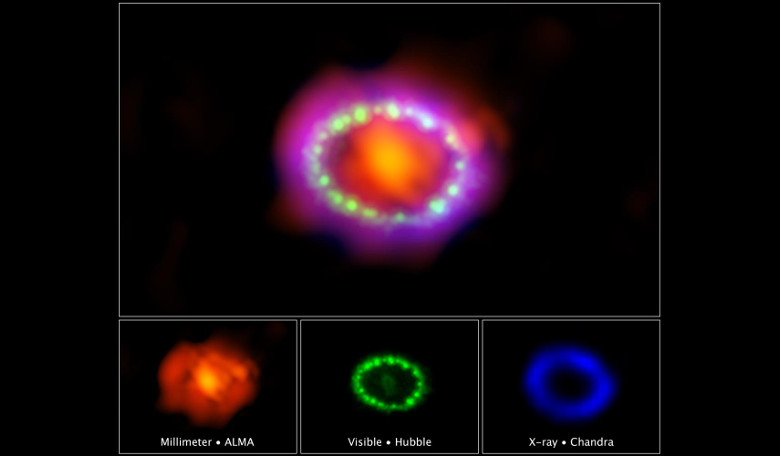To commemorate the 30th anniversary of the most famous supernova to date – SN 1987A – researchers have been working hard to construct time-lapse movies and a three-dimensional model so that the public can ‘see’ a supernova explosion in as much detail as they possibly can.
Just over three decades a go, supernova 1987A (SN 1987A), lit up the sky with the power of 100 million suns as it blazed for several months following its discovery on 23rd February, 1987. Located in the nearby Large Magellanic Cloud, SN 1987A was one of the brightest exploding stars to be observed by astronomers in more than 400 years and ever since then it has captured the imagination of all those fascinated by the titanic explosion of a dying star.
Observations of the supernova remnant have shown that the central structure within SN 1987A has now grown to roughly half a light-year across and that two blobs of debris in its centre are racing away from each other at roughly 20 million miles an hour.
The latest data from the telescopes that have been keeping an eye on it such as Hubble and Chandra, have revealed that SN 1987A has passed an important stage. Before a star goes supernova, it will undergo a series of mass loss events that sweep out gas ejected from the star by a slow-moving wind. As the star ages, the winds get faster and often outflows are produced by the star as it settles into its red giant phase of life. As the fast wind collides with the earlier produced material it forms a dense ring of material and, at present the shockwave generated by SN 1987A is moving beyond this ring of debris.
The dense ring of gas around SN 1987A – now visible in optical light – is roughly about a light-year in diameter and has been there for at least 20,000 years before the star exploded. From 1999 until 2013, data from the Chandra telescope showed an expanding ring of X-ray emission that had been steadily getting brighter, however in the past few years, these X-rays no longer light up the ring as they once did. This latest transition as the shockwave ploughs through it should therefore aid astronomers in gaining a better understanding of the life of the doomed star, and how it ended.
Getting in on the act of observing SN 1987A since 2012, is the Atacama Large Millimetre/Submillimetre Array (ALMA). Having been observed in X-rays, UV and optical light, astronomers are now using ALMA to observe the glowing remains of the supernova and studying how vast amounts of new dust is being forged from the new elements created in the progenitor star.
"A supernova remnant cools quickly, so within a few years the heavy elements formed in the star can form molecules and condense into dust, turning the remnant into a veritable dust factory,” said Remy Indebetouw of the National Radio Astronomy Observatory in Charlottesville, Va. "ALMA is now able to see this newly formed dust directly, and ongoing studies will help us understand how it forms and how supernovas seed interstellar space with the raw material for new planetary systems."
Aside from the dust, astronomers are also still looking for evidence of a neutron star or a black hole left behind by the blast. As the star exploded, a flash of neutrinos were detected prompting astronomers to suggest that a compact object formed as the centre of the star collapsed, however no telescope has yet to find any evidence for either of these objects yet.
To see SN 1987A in all of its glory (minus a black hole or neutron star), the latest visuals can be seen here, here and here (all links open up in a new window). These were made possible by combining several sources of information including simulations by Salvatore Orlando and collaborators at INAF-Osservatorio Astronomico di Palermo, Italy, and researchers from NASA, ESA, Penn State University and the Harvard-Smithsonian Center for Astrophysics, amongst others.











